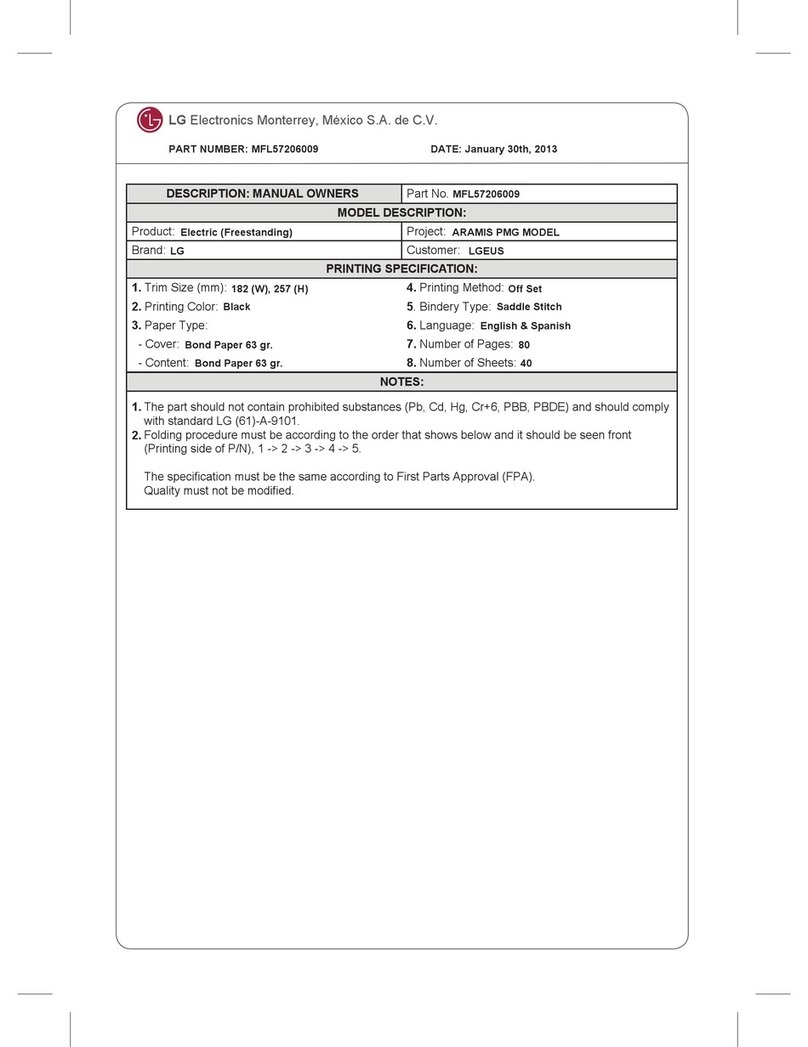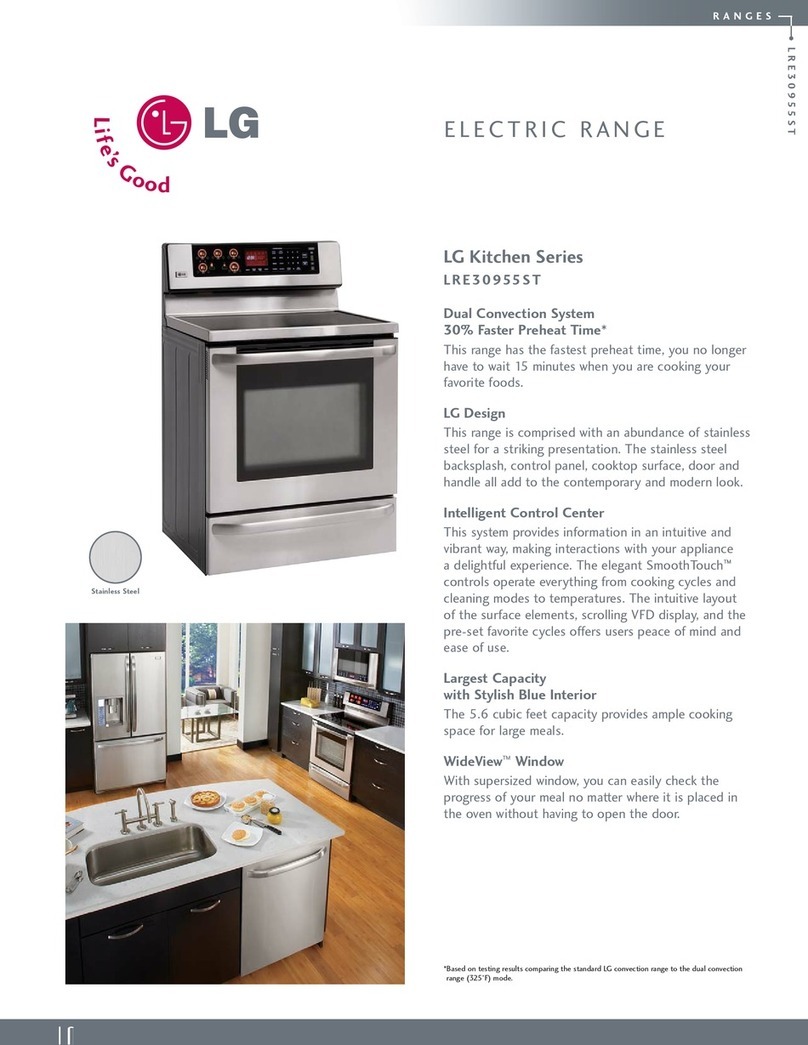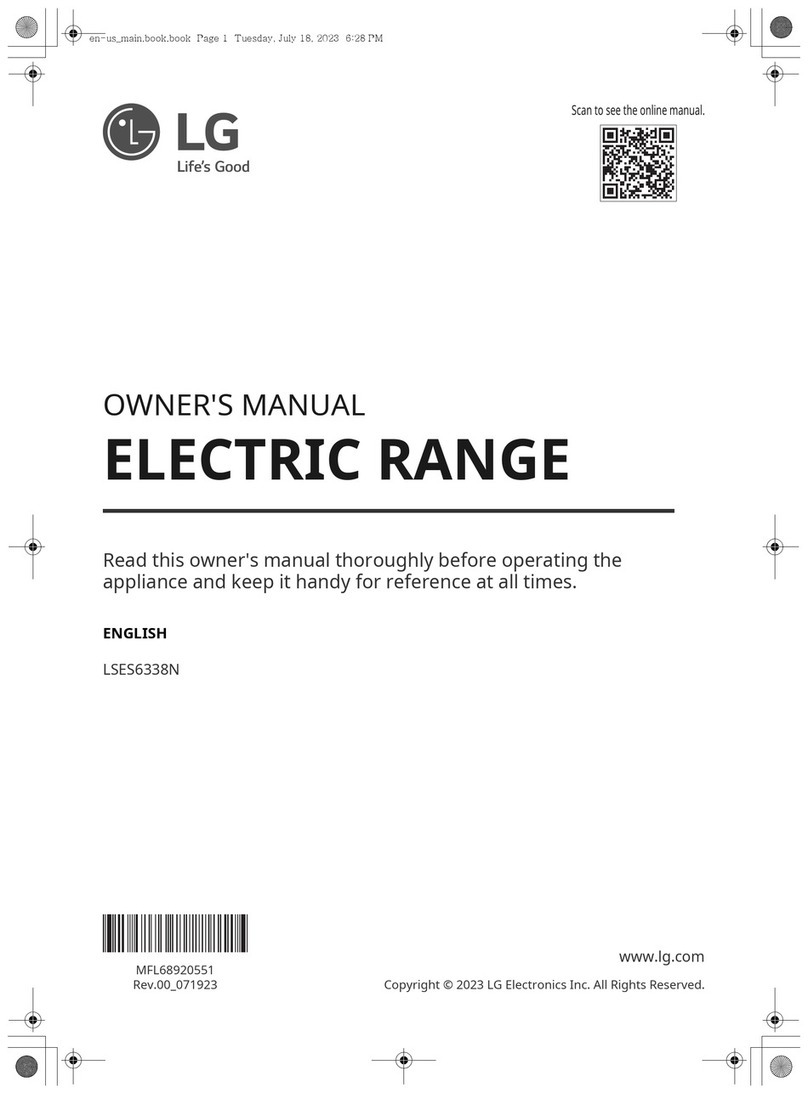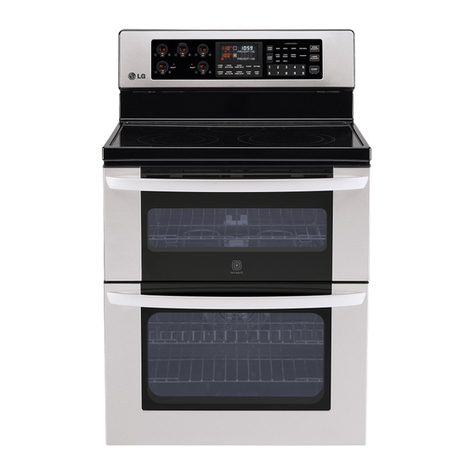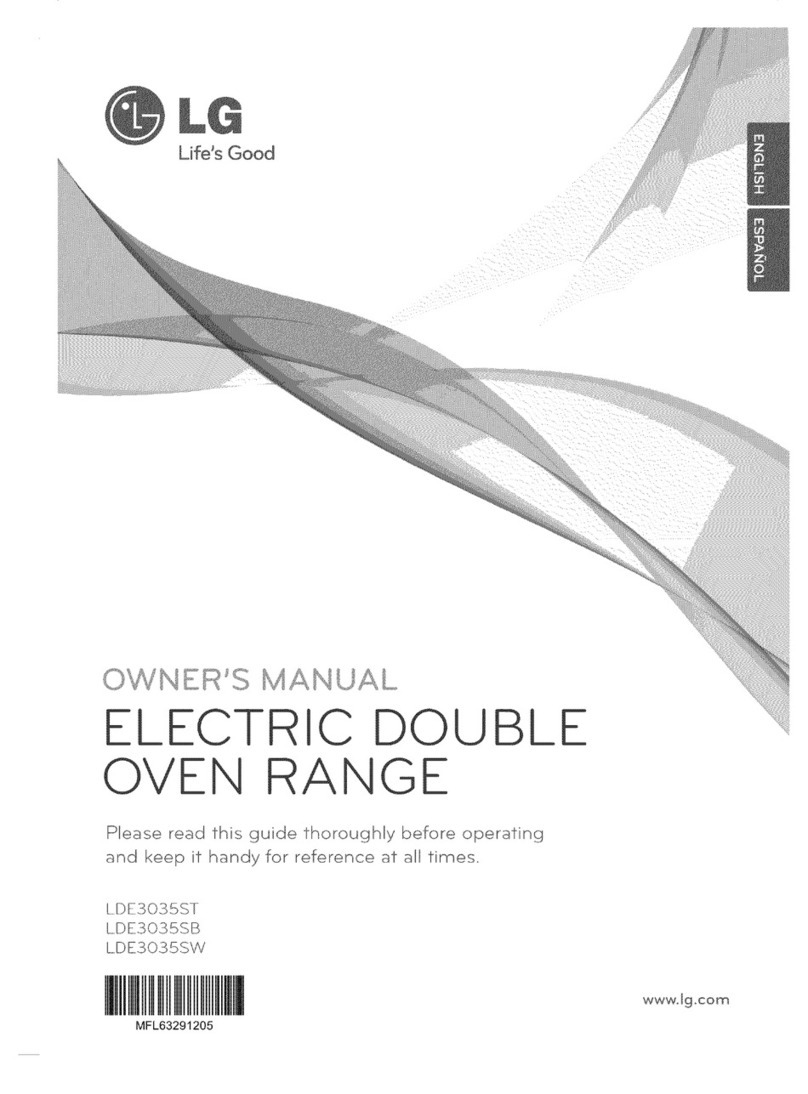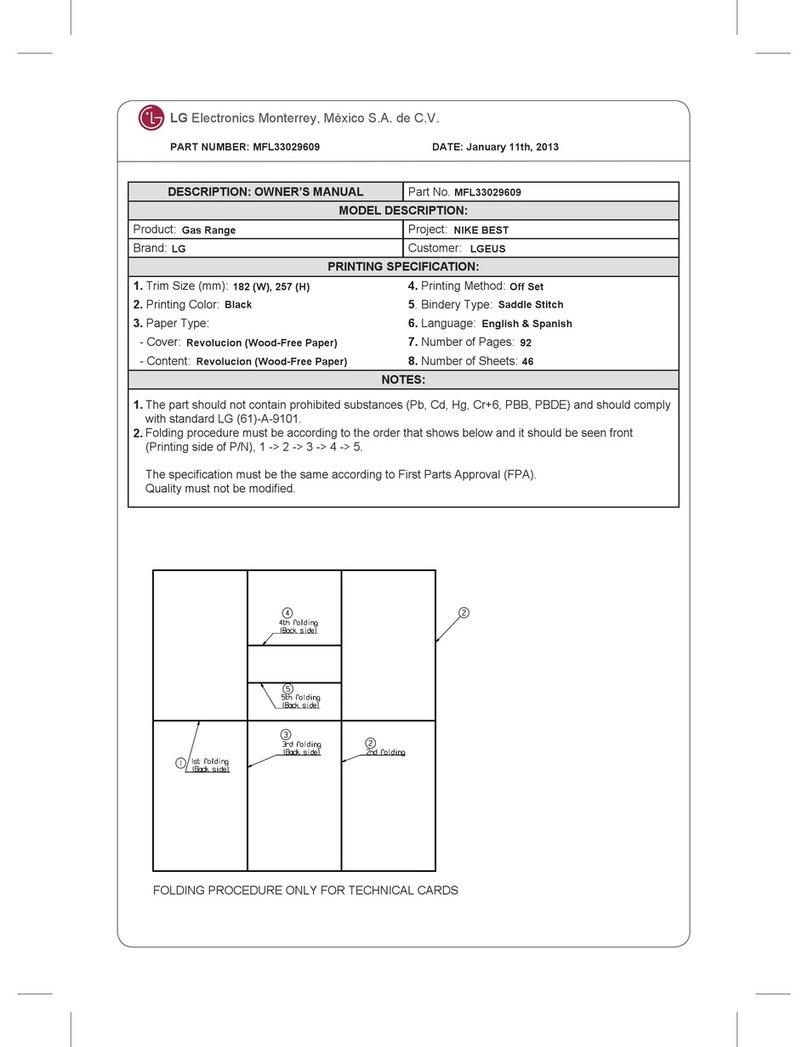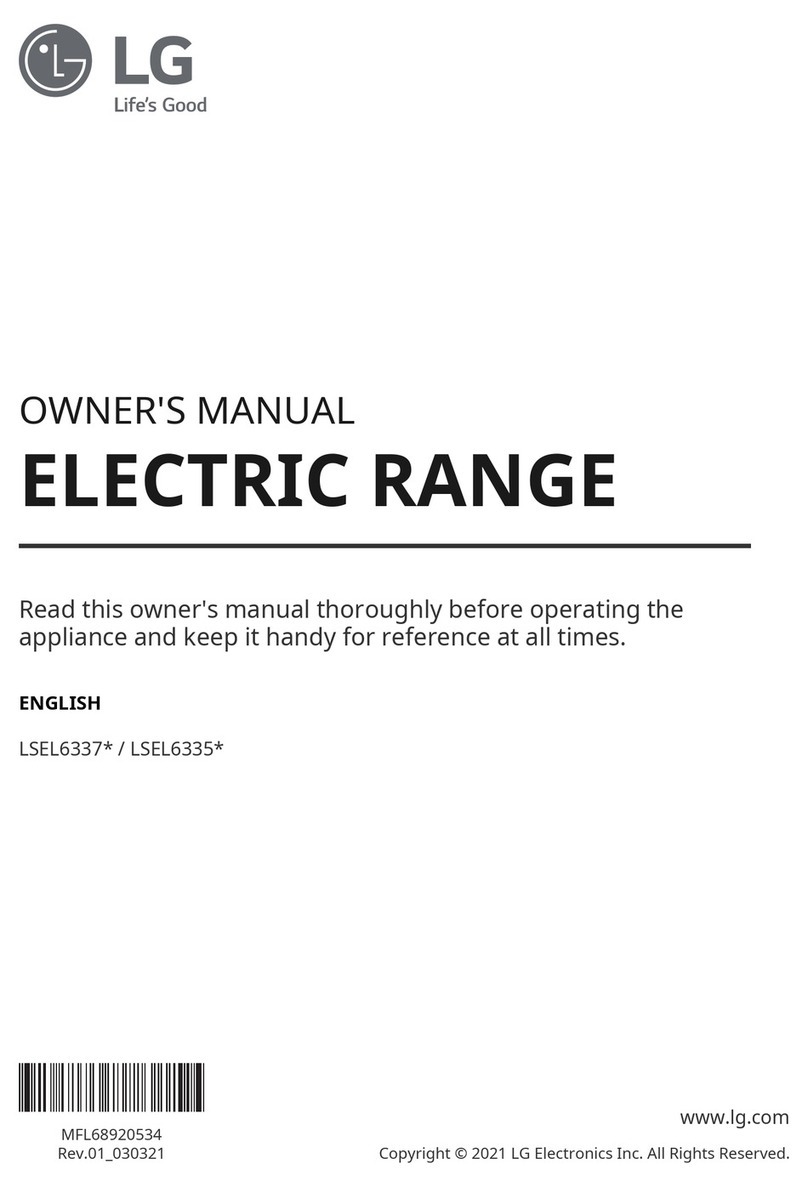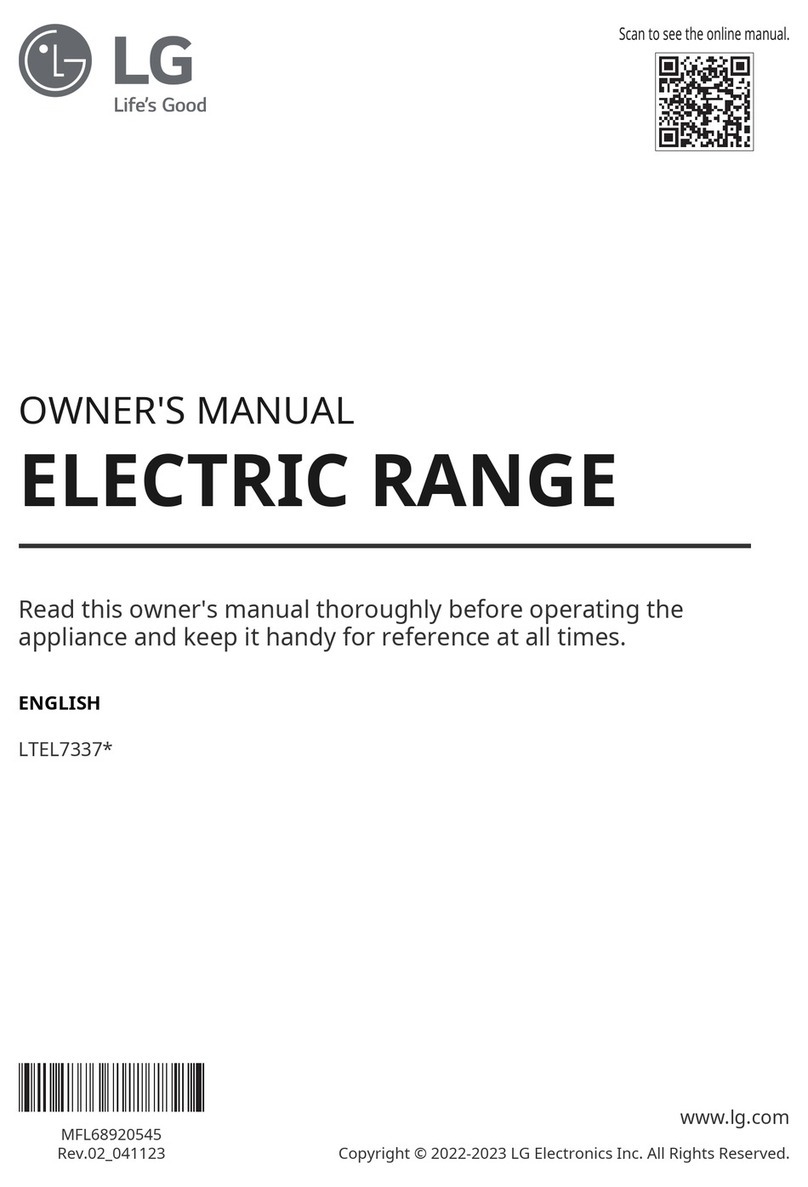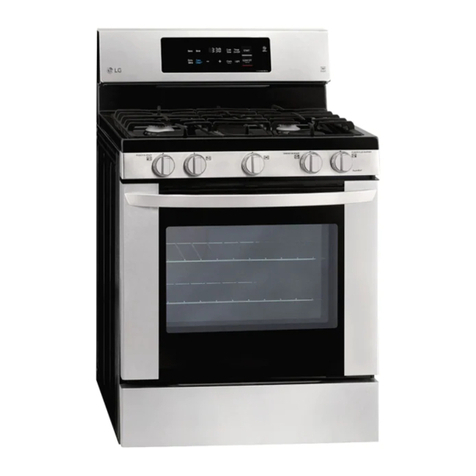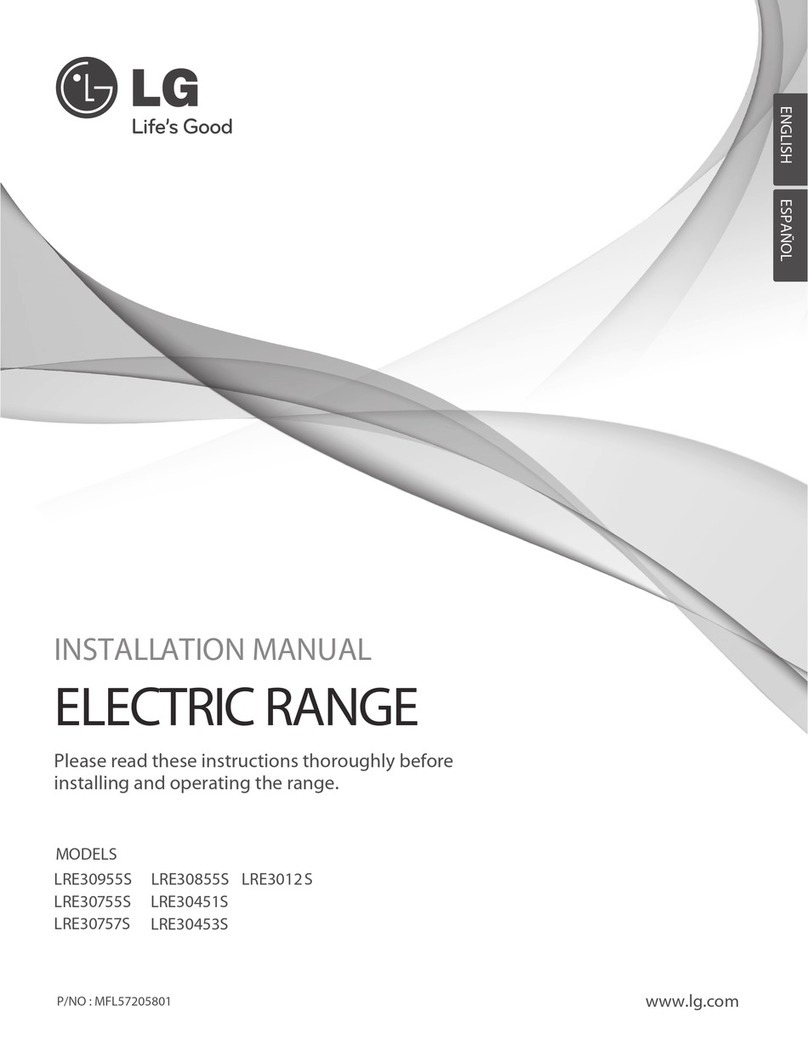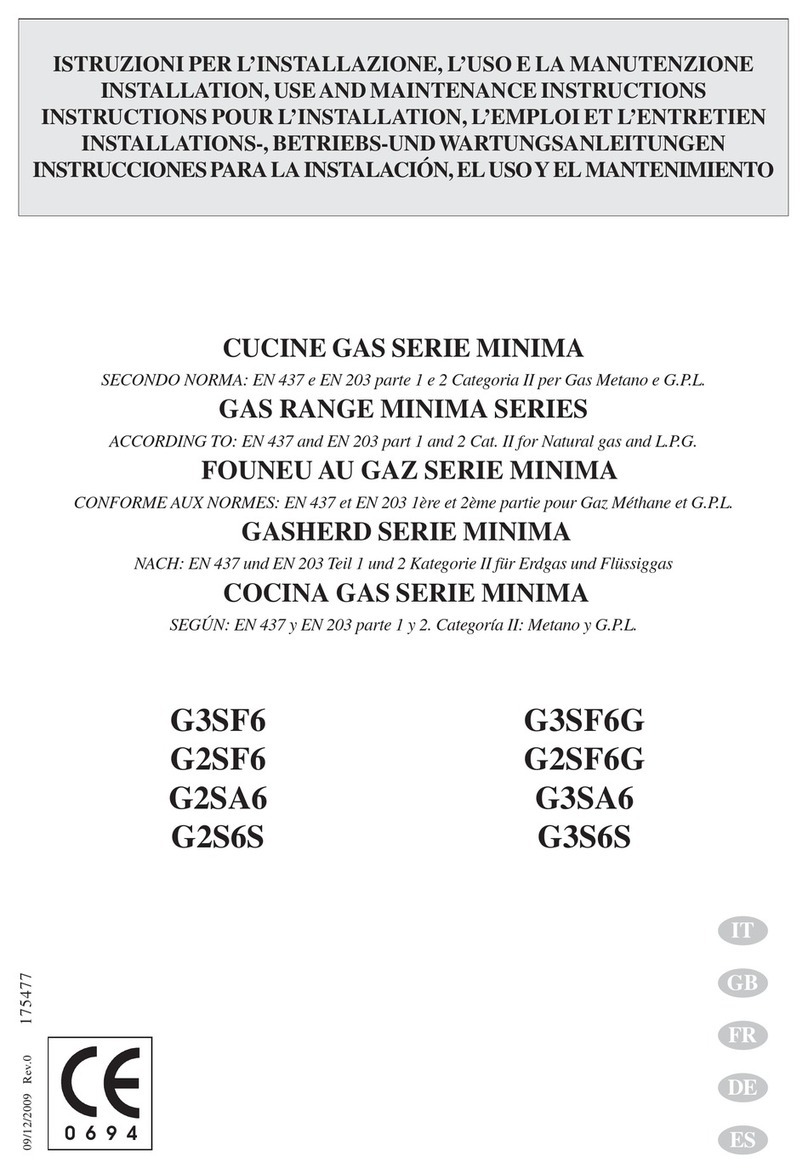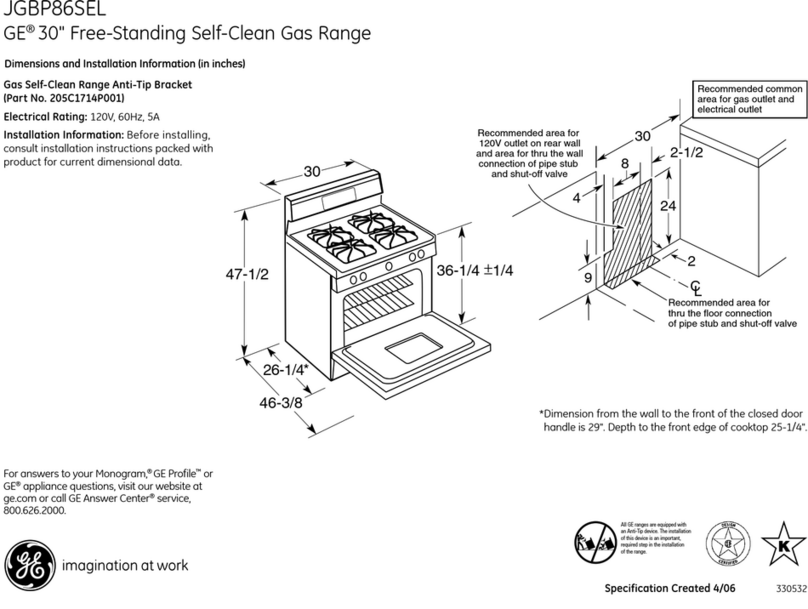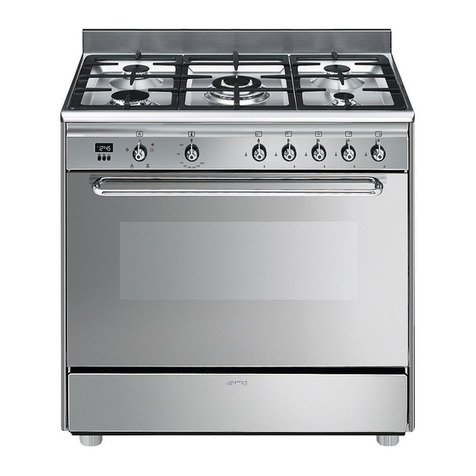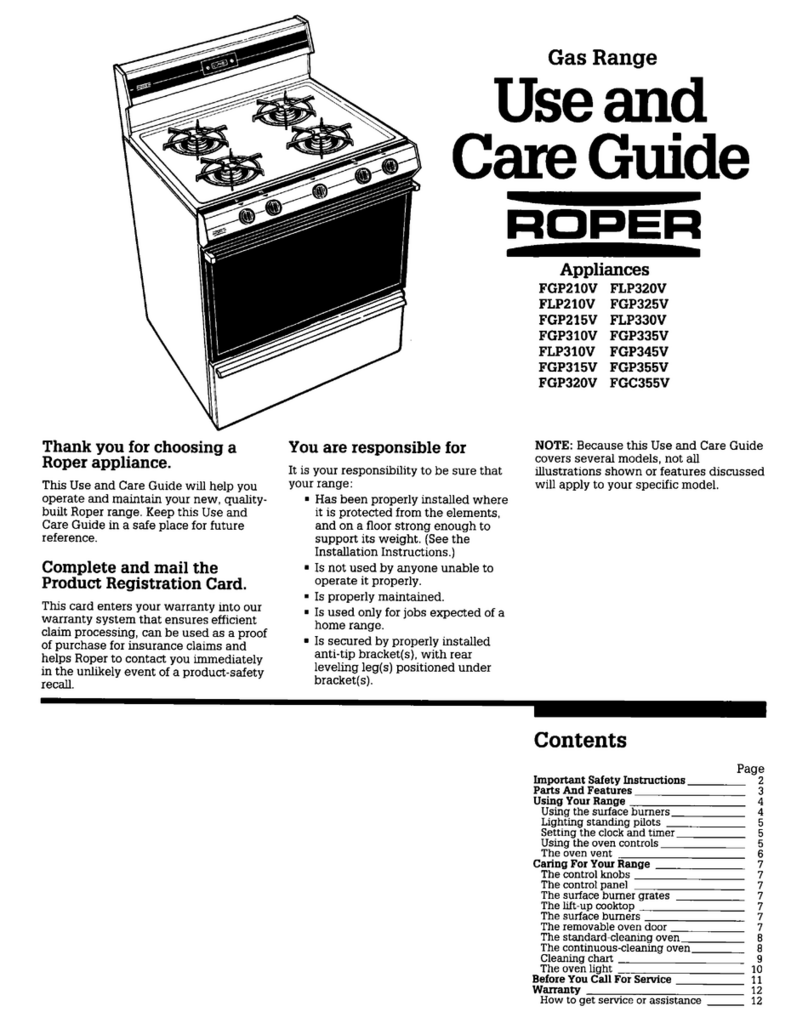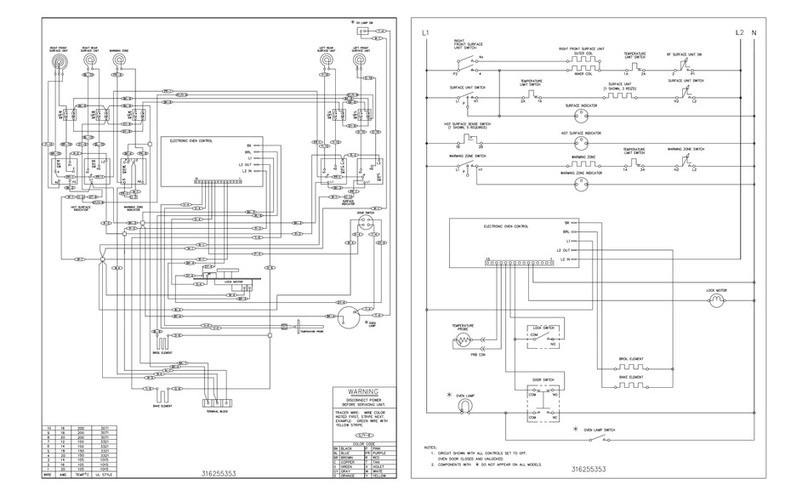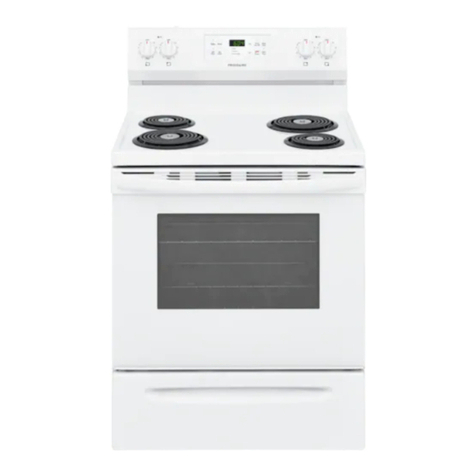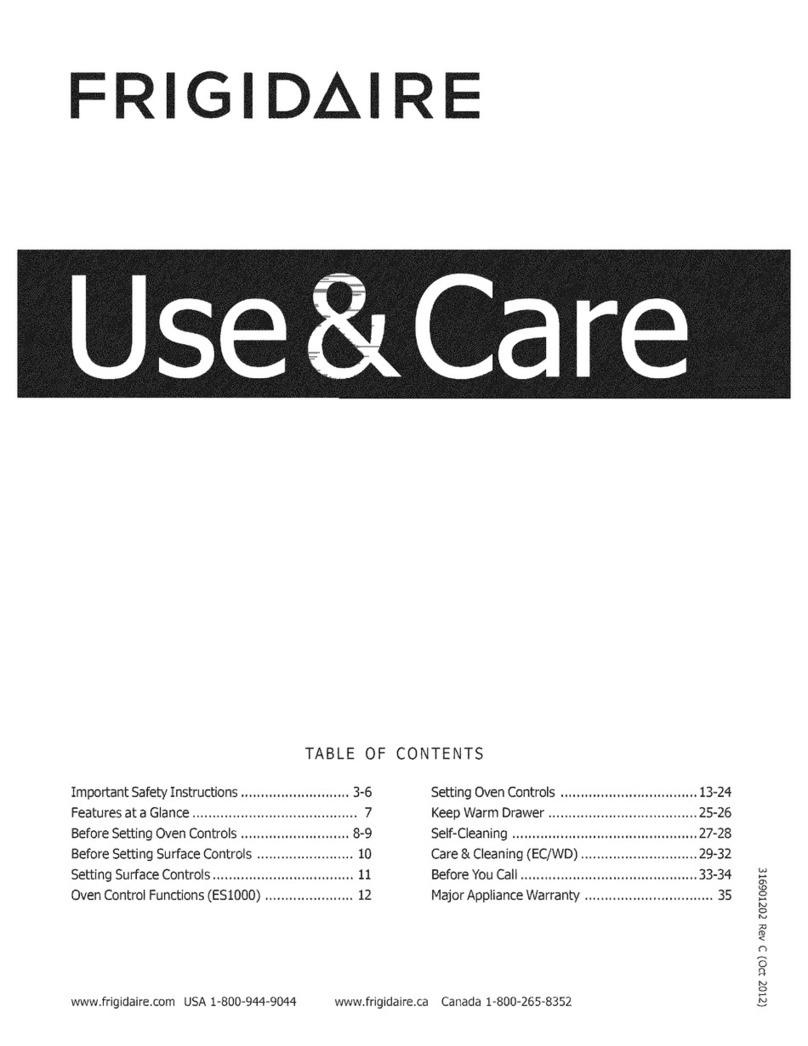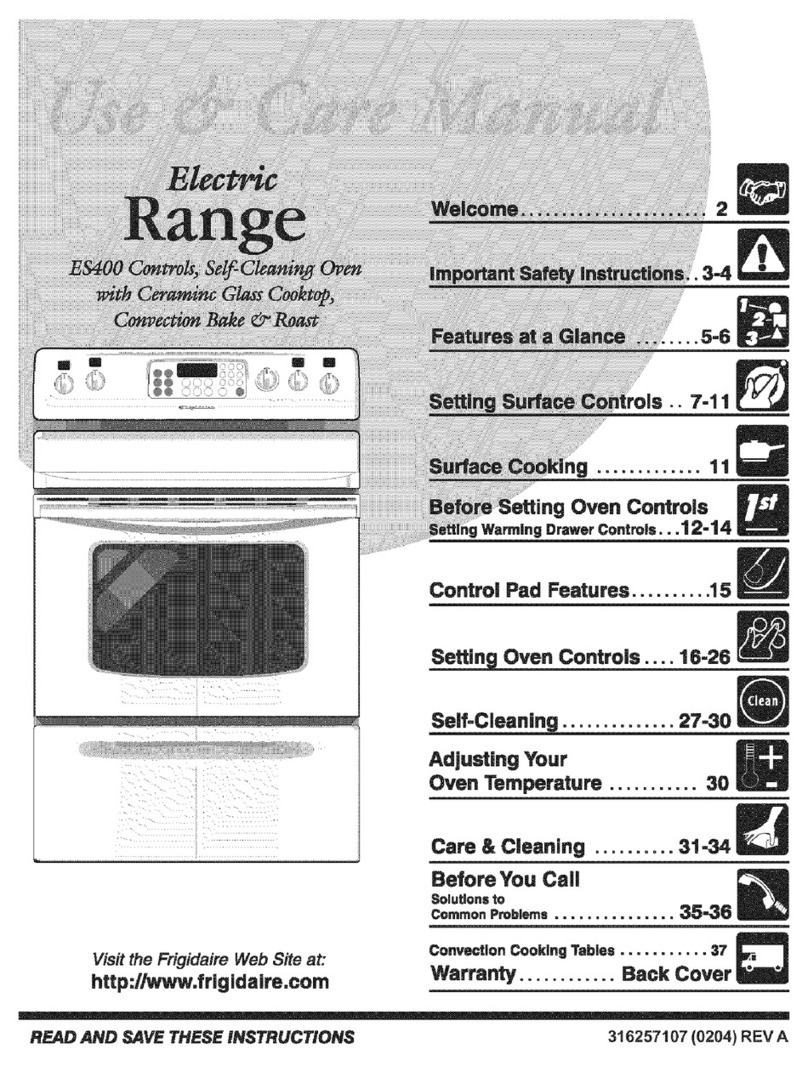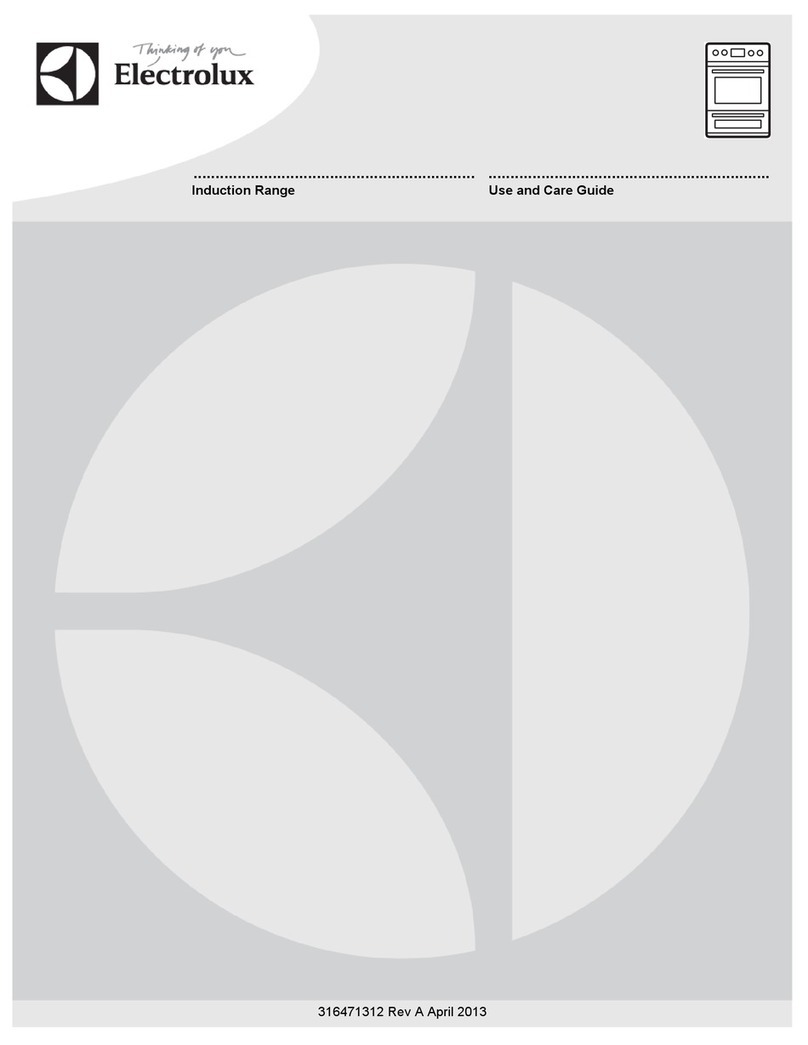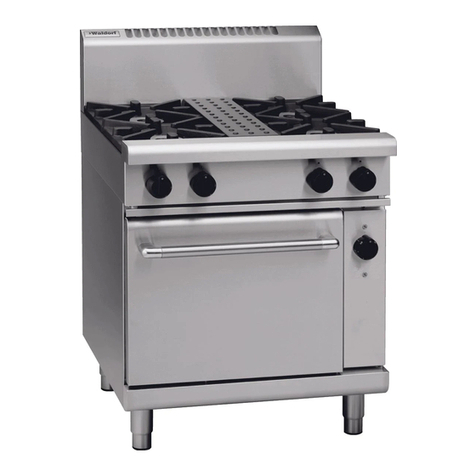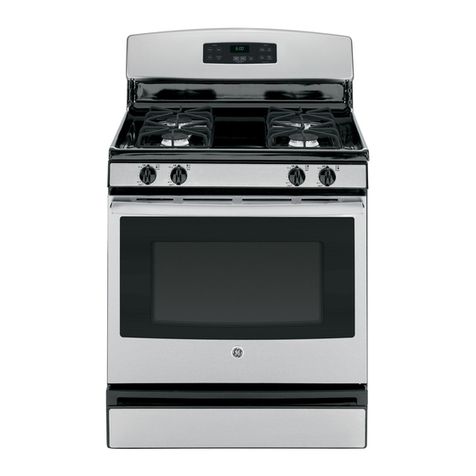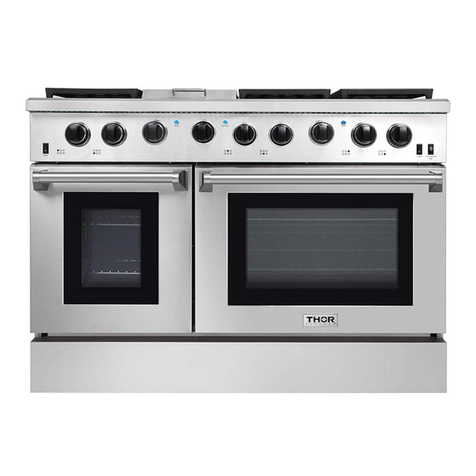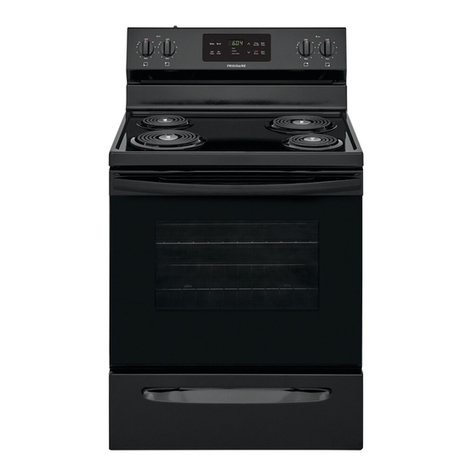LG LRE4213ST User manual

30” Freestanding Electric Range
SERVICE MANUAL
MODEL: LRE4213ST
CAUTION
BEFORE SERVICING THE UNIT, READ THE SAFETY PRECAUTIONS IN THIS MANUAL.
P/NO : MFL37118345
Nov, 2015
Printed in Korea
Internal Use Only

This LG Service Manual, “ 30” Freestanding Self-Cleaning Electric Range,” provides the
technician with information on the operation and service of the Freestanding Self-Cleaning
Electric Range. It is to be used as a training Service Manual. For specific information on the
model being serviced, refer to the “Owner’s Manual” or “Tech Sheet” provided with the electric
range.
SAFETY PRECAUTIONS
• Repairs of the appliance should be carried out by a licensed technician only. Incorrect repairs
may result in dangerous situations. If you need repairs done, contact an LG Service Center or
your dealer.
• If the power cord is defective, it must be replaced by a qualified service agent with a UL listed
range cord.
• Electrical leads and cables should not be allowed to touch the oven.
• Rating plate is located on the left side of warming drawer.
• The power supply of the appliance should be turned off when it is being repaired.
FORWARD
LG Electronics assumes no responsibility for any repairs made
on our products by anyone other than Authorized Service Technicians.
WARNING
• DISCONNECT power supply cord from the outlet before servicing.
• Replace all panels and parts before operating.
• RECONNECT all grounding devices.
- Failure to do so can result in severe personal injury, death or electric shock.
• DO NOT touch the oven when it is in operation.
- The interior parts will be very hot.

TABLE OF CONTENTS
(Page)
GENERAL
------------------------------------------------------------------------------------------------
1-1 ~ 1-5
• Important safety instructions
------------------------------------------------------------------------------------------
1-1 ~ 1-3
• Model & Serial number label and tech sheet locations
-------------------------------------------------------------
1-4
• Specifications
----------------------------------------------------------------------------------------------------------------------
1-5
USING YOUR RANGE
----------------------------------------------------------------------------
2-1 ~ 2-8
• General information
--------------------------------------------------------------------------------------------------------------
2-1
• Control panel features
--------------------------------------------------------------------------------------------------
2-2 ~ 2-6
- Setting the Clock
- Start, Clear/Off and On/Off pad
- To turn On/Off the oven light
- Timer On/Off
- Setting Pad : 7 types of category
1. Change hour mode on Clock
2. Convection Auto Conversion On/Off
3. Lower oven Temp Adjust
4. Upper oven Temp Adjust
5. Preheat alarm light On/Off
6. Beeper volume High/Low/Mute
7. Select Fahrenheit or Celsius temperature
- Timed Cook, Delayed Timed Cook
- Broil
- Convection Bake
- Convection Roast
- Pizza
- Warm
- Proof
- LockOut
- Self Clean
- Easy Clean
• Surface control panel feature
-----------------------------------------------------------------------------------------
2-7 ~ 2-8
COMPONENT ACCESS
------------------------------------------------------------------------
3-1 ~ 3-16
• Component Locations
----------------------------------------------------------------------------------------------------------
3-1
• Removing Control cover and Touch Glass Assembly
---------------------------------------------------------------
3-2
• Removing the Power Control Board (PCB)
-----------------------------------------------------------------------------
3-3
• Removing the Surface Element and the Ceramic Glass Cooktop
--------------------------------------------
3-4
• Removing the Door Lath and Door Switch
--------------------------------------------------------------------------------
3-5
• Removing the BROIL element
-----------------------------------------------------------------------------------------------
3-6
• Removing the CONVECTION element, Fan blade and Fan motor
---------------------------------------------
3-7
• Removing the Oven light & Socket assembly
--------------------------------------------------------------------------
3-8
• Removing the latch drive assembly
----------------------------------------------------------------------------------------
3-9
- Door locking mechanism
---------------------------------------------------------------------------------------------------
3-9
• Removing the Oven temperature Sensors
----------------------------------------------------------------------------
3-10
• Removing & Replacing the Lift-off Oven Door and Drawer
---------------------------------------------
3-11~ 3-12
• Removing the Upper Oven Door Handle & Glass
---------------------------------------------------------
3-13 ~ 3-14
• Removing the Oven Door Gasket
----------------------------------------------------------------------------------------
3-15
• Removing a Side Panel
------------------------------------------------------------------------------------------------------
3-16

(Page)
COMPONENT TEST
------------------------------------------------------------------------------
4-1 ~ 4-10
•
Convection Motor
----------------------------------------------------------------------------------------------------------------
4-1
•
Door locking Motor
--------------------------------------------------------------------------------------------------------------
4-2
•
Micro Switch
------------------------------------------------------------------------------------------------------------------------
4-2
•
Oven Sensor
---------------------------------------------------------------------------------------------------------------------
4-2
•
Door switch
------------------------------------------------------------------------------------------------------------------------
4-3
• Outer Broil heater
----------------------------------------------------------------------------------------------------------------
4-3
• Convection heater
----------------------------------------------------------------------------------------------------------------
4-3
• Oven lamp
---------------------------------------------------------------------------------------------------------------------------
4-3
• Infinite switch
(Single units):
---------------------------------------------------------------------------------------------------
4-4
• Infinite switch
(Double units):
----------------------------------------------------------------------------------------
4-4 ~ 4-5
• Single surface units:
--------------------------------------------------------------------------------------------------------------
4-7
• Center Rear(CR) Element:
----------------------------------------------------------------------------------------------------
4-8
•
Dual surface unit
-----------------------------------------------------------------------------------------------------------------
4-9
• Triple surface unit :
------------------------------------------------------------------------------------------------------------
4-10
COMPOSITION OF CONTROL
----------------------------------------------------------------
5-1 ~ 5-3
• Wiring Diagram
---------------------------------------------------------------------------------------------------------------------
5-1
• Composition of Control
----------------------------------------------------------------------------------------------------------
5-2
• Main PCB
-----------------------------------------------------------------------------------------------------------------------------
5-3
• Relay PCB
---------------------------------------------------------------------------------------------------------------------------
5-3
• Touch PCB
----------------------------------------------------------------------------------------------------------------------------
5-4
• NFC and Buzzer PCB
------------------------------------------------------------------------------------------------------------
5-4
SERVICE TEST MODE
----------------------------------------------------------------------------
6-1 ~ 6-3
• Sequence SVC test mode
------------------------------------------------------------------------------------------------
6-1~6-2
• Basic check summary
------------------------------------------------------------------------------------------------------------
6-3
TROUBLESHOOTING
---------------------------------------------------------------------------
7-1 ~ 7-21
• Check the Failure code
----------------------------------------------------------------------------------------------------------
7-1
• Failure code summary
------------------------------------------------------------------------------------------------------------
7-2
• No display (No Power)
------------------------------------------------------------------------------------------------------
7-3~7-4
• Oven does not heat
----------------------------------------------------------------------------------------------------------
7-5~7-8
• Door lock system error
---------------------------------------------------------------------------------------------------
7-9~7-12
• Oven sensing error
------------------------------------------------------------------------------------------------------
7-13~7-15
• Oven hot error
------------------------------------------------------------------------------------------------------------
7-16~7-19
• Key not work
---------------------------------------------------------------------------------------------------------------
7-20~7-21
•
Key operation test sequence
----------------------------------------------------------------------------------------------
7-22
SCHEMATIC DIAGRAM
--------------------------------------------------------------------------
8-1 ~ 8-3
• STRIP CIRCUITS
---------------------------------------------------------------------------------------------------------
8-2 ~ 8-3
EXPLODED VIEW
-----------------------------------------------------------------------------------
9-1 ~ 9-7

1-1
GENERAL
IMPORTANT SAFETY INSTRUCTIONS
Read and follow all instructions before using your oven to prevent the risk of fire, electric shock, injury to person, or
damage when using the range. This guide don’t cover all possible conditions that may occur. For further assistance
contact your service agent or manufacturer.
This is the safety alert symbol. This symbol alerts you to potential hazards that can kill or hunt you
and others. All safety messages will follow the safety alert symbol and either the word “WARNING”
or “CAUTION”. These word means :
WARNING
This symbol will alert you to hazards or unsafe practices which could cause
serious bodily harm or death.
CAUTION
This symbol will alert you to hazards or unsafe practices which could cause
bodily injury or property damage.
WARNING
• DO NOT step or sit on the door and install the Anti-Tip Bracket packed with range.
- The range could be tipped and injury might result from spilled hot liquid, food, or the range itself.
• DISCONNECT power supply cord from the outlet before servicing.
• Replace all panels and parts before operating.
• RECONNECT all grounding devices.
- Failure to do so can result in severe personal injury, death or electrical shock.
• DO NOT touch heating elements or interior surfaces of oven.
-Heating element may be hot even though they are dark in color.
-Interior surfaces of an oven become hot enough to cause burns.
• During and after use, do not touch, or let clothing or other flammable materials
contact heating elements or interior surfaces of oven until they have had sufficient
time to cool.
-
Other surfaces of the appliance may become hot enough to cause burns among these surfaces are oven vent
openings and surfaces near these openings, oven doors, and windows of oven doors.
• DO NOT store items of interest to children in cabinets above a range or on the back guard of
a range.
- Children climbing on the range to reach items could be seriously injured.
CAUTION
• Always use Pot Holders or oven mitts when removing food from the Warming Drawer.
- You can be burned as cookware and plates will be hot.
• Use caution when handling sheet metal parts while servicing the range.
- Some parts may have sharp edges, which could result in injury.
• Be careful not to bend the fan blade
- Failure to do so can result in vibration, noise, and poor performance of convection when operating.
• Be careful not to scratch or chip the oven liner paint when you remove the oven light
socket.
• Turn power OFF before removing the Warming Drawer.
• Be careful when removing and lifting the door.
• DO NOT lift the door by the handle.
- Doing so can result in personal injury as the door is very heavy.

1-2
GENERAL
IMPORTANT SAFETY INSTRUCTIONS
• Be sure your appliance is properly installed and grounded by a
qualified technician.
• Do not repair or replace any part of the appliance unless
specifically recommended in the manual.
All other servicing should be referred to a qualified technician.
• Always disconnect power to appliance before servicing by
removing the fuse or switching off the circuit breaker
To reduce the risk of tipping of the range, the range must be
secured by properly installed anti-tip devices. To check if the
bracket is installed properly,
Refer to the installation manual for proper anti-tip bracket
installation.
WARNING
• DO NOT touch heating elements or
interior surfaces of oven.
-Heating element may be hot even though they are
dark in color.
-Interior surfaces of an oven become hot enough to
cause burns.
• During and after use, do not touch, or
let clothing or other flammable
materials contact heating elements or
interior surfaces of oven until they
have had sufficient time to cool.
-
Other surfaces of the appliance may become hot
enough to cause burns among these surfaces are
oven vent openings and surfaces near these
openings, oven doors, and windows of oven doors.
WARNING
• DO NOT store items of interest to
children in cabinets above a range or
on the back guard of a range.
- Children climbing on the range to reach items
could be seriously injured.
WARNING
• DO NOT step or sit on the
door and install the Anti-Tip
Bracket packed with range.
- The range could be tipped and injury
might result from spilled hot liquid, food,
or the range itself.

1-3
GENERAL
SURFACE COOKING UNITS
• Use Proper Pan Size – This appliance is equipped with one or
more surface units of different sizes. Select utensils having flat
bottoms large enough to cover the surface unit heating element.
The use of undersized utensils will expose a portion of the heating
element to direct contact and may result in ignition of clothing.
Proper relationship of utensil to burner will also improve efficiency.
• Never Leave Surface Units Unattended at High Heat Settings
– Boil overs may cause smoking and greasy spillovers may ignite.
• Make Sure Reflector Pans or Drip Bowls Are in Place –
Absence of these pans or bowls during cooking may subject
wiring or components underneath to damage.
• Protective Liners – Do not use aluminum foil to line surface unit
drip bowls or oven bottoms, except as suggested in the manual.
Improper installation of these liners may result in a risk of electric
shock, or fire.
• Glazed Cooking Utensils – Only certain types of glass, glass/
ceramic, ceramic, earthenware, or other glazed utensils are
suitable for range-top service without breaking due to the sudden
change in temperature.
• Utensil Handles Should Be Turned Inward and Not Extend
Over Adjacent Surface Units – To reduce the risk of burns,
ignition of flammable materials, and spillage due to unintentional
contact with the utensil, the handle of a utensil should be
positioned so that it is turned inward, and does not extend over
adjacent surface units.
• Do Not Soak Removable Heating Elements – Heating elements
should never be immersed in water.
• Be sure you know which control pads operate each surface unit.
Make sure you turned on the correct surface unit.
IMPORTANT SAFETY INSTRUCTIONS
SELF-CLEAN OVENS
• Do Not Clean Door Gasket – The door gasket is essential for
a good seal. Care should be taken not to rub, damage, or
move the gasket.
• Do Not Use Oven Cleaners – No commercial oven cleaner or
oven liner protective coating of any kind should be used in or
around any part of the oven.
• Clean in the self-clean cycle only parts listed in this
manual. Before self-cleaning the oven, remove the broiler pan
and any utensils from the oven.
• Never keep pet birds in the kitchen – the health of birds is
extremely sensitive to the fumes released during an oven self-
clean cycle. Fumes may be harmful or fatal to birds. Move
birds to well-ventilated room.
• Important Instruction – In the event the self-clean mode “F”
code goes on, or three long beeps sound, oven is
malfunctioning in the self-clean mode. Turn off or disconnect
appliance from power supply and have serviced by a qualified
technician.
VENTILATING HOODS:
• Clean Ventilating Hoods Frequently – Grease should
not be allowed to accumulate on hood or filter.
• When flaming foods under the hood, turn the fan
on.
OVEN
• Use Care When Opening Door – Let hot air or steam escape
before you remove or replace food in the oven
• Do Not Heat Unopened Food Containers – Build-up of
pressure may cause container to burst and result in injury.
• Keep Oven Vent Ducts Unobstructed – the oven vent is
located above the left rear surface unit. this area could
become hot during oven use. Never block this vent and never
place plastic or heat-sensitive items on vent
• Placement of Oven Racks – Always place oven racks in
desired location while oven is cool. If rack must be moved
while oven is hot, do not let potholder contact hot heating
element in oven.
• Do Not allow aluminum foil or meat probe to contact heating
elements.
GLASS/CERAMIC COOKING SURFACES
• Do Not Cook on Broken Cook-Top – If cook-top should
break, cleaning solutions and spillovers may penetrate the
broken cook-top and create a risk of electric shock. Contact a
qualified technician immediately.
• Clean Cook-Top With Caution – If a wet sponge or cloth is
used to wipe spills on a hot cooking area, be careful to avoid
steam burn. Some cleaners can produce noxious fumes if
applied to a hot surface.
DEEP FAT FRYERS:
• Use extreme caution when moving the grease kettle or
disposing of hot grease.
• Do Not Leave Children Alone - Children should not be left alone
or unattended in area where appliance is in use. They should
never be allowed to sit or stand on any part of the appliance.
• Never Use Your Appliance for Warming or Heating the Room.
• Storage in or on Appliance – Flammable materials should not
be stored in an oven or near surface units. Be sure all packing
materials are removed from the appliance before operating it.
Keep plastics, clothes and paper away from parts of the appliance
that may become hot
• Wear Proper Apparel – Loose-fitting or hanging garments should
never be worn while using the appliance.
• Do Not Use Water on Grease Fires – Turn off oven to avoid
spreading the flame. Smother the fire or flame by closing the door
or use dry chemical, baking soda or foam- type extinguisher.
• Use Only Dry Potholders – Moist or damp potholders on hot
surfaces may result in burns from steam.
Do not let potholder touch hot heating elements. Do not use a
towel or other bulky cloth.
WARNING
• DISCONNECT power supply cord from
the outlet before servicing.
• Replace all panels and parts before
operating.
• RECONNECT all grounding devices.
- Failure to do so can result in severe personal
injury, death or electrical shock.

1-4
GENERAL
The Model/Serial Number label and Tech Sheet locations are shown below.
Model & Serial
Number Location
MODEL & SERIAL NUMBER LABEL
AND TECH SHEET LOCATIONS
Tech Sheet Location
(On Lower Rear Cover)

1-5
GENERAL
SPECIFICATIONS
Model Number LRE4213ST
Category Single oven range
Overall Width 297⁄8
Installation type Freestanding
Color availability STS
Control Oven Glass Touch
Cooktop Knob
Display VFD
Electronic clock & timer Yes
Control lock capability Yes
Audible preheat signal Yes
Special function Setting (6 categories)
1. Change hour mode on Clock
2. Convection Auto Conversion On/Off
3. Oven Temp Adjust
4. Preheat alarm light On/Off
5. Beeper volume High/Low/Mute
6. Select Fahrenheit or Celsius temperature
Cooktop Material Ceramic glass
# of element 5
Power LR 6"- 1,200 W
RR 6"- 1,200 W
CR 7"-100 W
LF 9"/6"- 3,200 W/1,400 W
RF 12”/9” – 2700W/1700 W
Oven Capacity(cu.ft) 6.3
Broil element 4200 W
Bake element No
Convection system Yes
Convection element 2500W
# of Racks 3 Standard
Interior oven light 120V, 40W
Proof Yes
Cook & warm Yes
Favorites No
Easy clean Yes
Door lockout Yes
Drawer Type Storage drawer
Element NO
Warming rack Yes
Dimensions
(inch)
Oven Interior(W x H x D) 24 7/8x 21 3/8x 20
Exterior-Width 29 7/8
Exterior-Height 35 15/16(Cooktop), 47 5/16 (Backguard)
Exterior-Depth 26 9/16(Door), 28 7/8 (Handle)
Net weight:Lbs(kg) 187.8 lbs (85.2kg)
Power Rating 13.5Kw(120/240V AC) / 10.1Kw(120/208V AC)

2-1
Rating Label
Model numbers are recorded on the rating label.
Rating label is located on the lower front left corner
of the oven frame. It can be seen by opening the
storage drawer or warming drawer. Before ordering
parts, write down the correct model and serial
number from rating label. This avoids incorrect
shipments and delays. Please refer to parts
reference material when ordering replacement parts.
Functional Operation
Bake Mode
Upper and rear elements operate during bake.
Bake can be used to cook foods which are normally
baked. Oven must be preheated.
Broil Mode
Top element operates during broil. Broil can be used
to cook foods which are normally broiled. All foods
should be turned at least once except fish, which
does not need to be turned.
USING YOUR RANGE
GENERAL INFORMATION
Convection Bake / Roast Mode
Upper element, lower element, Rear element(some
model) and fan operate during convection bake.
Convection bake should be used for cooking
casseroles and roasting meats. Oven should be
preheated for best results when using convection
bake. Pans do not need to be staggered. Difference
between bake and convection mode is fan speed
and amount of cycling time. When cook with bake
mode, fan speed and amount of cycle tine is lower
than convection mode. Difference between
convection bake and convection roast at high
temperature (More 330F) is that amount of broil
cycling time. Broil cycling time of convection roast is
more than twice than convection bake mode.
Cooking Guide
Refer to the owners manual for recommendations of
times and temperatures. Times, rack position, and
temperatures may vary depending on conditions
and food type. For best results, always check food
at minimum time. When roasting, choose rack
position based on size of food item.
Broil element
Convection
element
Broil element
Broil element

2-2
USING YOUR RANGE
CONTROL PANEL FEATURES
❽
❶❷ ❷❸ ❹ ❺
❼ ❻
❾
❶Oven Control
❷Features
❸Number Keys
❹Start Key
❺NFC Tag On
❻Smart DiagnosisTM:
❼Clear Off / Lockout Key
❽Speed Broil Key
- LRE4215ST Only:
❾Cooktop Elements
Hot Surface Indicator
The hot surface indicator light glows as long as any surface cooking area is too hot to touch.
It remains on after the element is turned off and until the surface has cooled to approximately 150 ˚F.
Flashing Time
If your oven displays a flashing clock, touch Clock and reset the time, or touch any key to stop the flashing.

2-3
USING YOUR RANGE
2) CONVECTION AUTO CONVERSION
1. Touch Settings repeatedly until Auto
appears in the display.
2. Touch 1 to disable or enable auto
conversion.
3. Touch Start to accept the change.
3) THERMOSTAT ADJUSTMENT
1. Touch Settings repeatedly until AdJU
appears in the display.
2. Use the number keys to enter the number of
degrees you want to adjust the oven
temperature.
3. Adjust the temperature either up or down by
touching Settings repeatedly to toggle
between plus (+) or minus (-).
4. Touch Start to accept the change.
4) PREHEATING ALARM LIGHT ON/OFF
1. Touch Settings repeatedly until PrE appears
in the display.
2. Touch 1 to turn the light on/off.
3. Touch Start to accept the change.
5) BEEPER VOLUME
1. Touch Settings repeatedly until Beep
appears in the display.
2. Touch 1 to select Hi, Lo or Off.
3. Touch Start to accept the change.
6) TEMPERATURE UNIT (°F or °C)
1. Touch Settings repeatedly until Unit appears
in the display.
2. Touch 1 to select F (Fahrenheit) or C
(Celsius).
3. Touch Start to accept the change.
1. SETTING THE CLOCK
1. Touch START pad to start oven.
2. Touch UPPER or LOWER CLEAR OFF pad
to cancel a program during cooking or
Erase during programming.
3. Touch ON/OFF pad to start or cancel the
surface unit.
2. TO TURN ON/OFF THE OVEN LIGHT
The oven light automatically turns ON when
the door is opened. The oven light may also be
manually turned ON or OFF by pressing the
OVEN LIGHT pad
NOTE: The oven light cannot be turned on if self-clean
feature is active.
3. TIMER ON/OFF
The Timer On/Off serves as an extra timer in the
kitchen that beeps when the set time has run out.
It does not start or stop cooking.
The Timer On/Off feature can be used during any
of the oven control functions.
SETTING THE TIMER (FOR EXAMPLE TO SET
5 MINUTES)
1. Touch Timer On/Off once.
0:00 appears and Timer flashes in the
display.
2. Touch 5.
0:05 appears in the display.
3. Touch Timer On/Off to start the Timer. The
remaining time countdown appears in the
display.
4. When the set times runs out, End show in
the display. The indicator tones sound every
15 seconds until Timer On/Off is touched.
NOTE: If Timer On/Off is not touched, the timer returns
to the time of day.
4. SETTING PAD: 6 TYPES OF CATEGORY
1) CHANGE HOUR MODE ON CLOCK
The control is set to use a 12-hour clock. To
reset the clock to 24-hour mode, follow the
steps below.
1. Touch Settings once.
2. Touch 1 to toggle between a 12-hour and
24-hour clock.
3. Touch Start to accept the change.

2-4
USING YOUR RANGE
5. BAKE, TIMED BAKE, DELAYED TIMED
BAKE
* This feature can also be used with the:
CONVECTION BAKE and CONVECTION ROAST
modes.
6. OVEN LOCKOUT
1. Touch and hold Clear/Off for three seconds.
2. The lock melody sounds, Loc appears in the
display and the lock blinks in the display.
3. Once the oven door is locked, the lock
indicator stops blinking and remains on.
4. To deactivate the Lockout feature, touch and
hold Clear/Off for three seconds. The unlock
melody sounds
7. SELF-CLEAN
1. Remove all racks and accessories from the
oven.
2. Touch Self Clean. The oven defaults to the
recommended four-hour self clean for a
moderately soiled oven. Touch twice for a
five hour self clean or three times for a
three-hour self clean.
3. Touch Start.
4. Once the self-clean cycle is set, the oven
door locks automatically and the lock icon
displays. You will not be able to open the
oven door until the oven has cooled. The
lock releases automatically when the oven
has cooled.
BAKE Desired
temperature START
COOK
TIME Desired time START
START
TIME
Desired
start time START

2-5
USING YOUR RANGE
Use to turn on the surface elements. An infinite
choice of heat settings is available from LOW to
HIGH The knobs can be set on or between any of
settings.
To turn on a Single element:
1. Push the Single element knob in.
2. Turn the knob in either direction to the
desired setting.
The control knob clicks when it is positioned
at both Off and Hi.
Single
Off On
Note:
• Hi is the highest temperature available.
• Lo is the lowest temperature available.
To turn on the Dual element:
There is one dual element located in the left front
position. Use the dual element as a dual or single
element.
1. Push in the appropriate knob.
2-A. Turn the knob counterclockwise to use it
as a Single element.
2-B. Turn the knob clockwise to use it as a
Dual unit.
Heating with inner
(smaller) element only
Heating with both
elements together
A B

2-6
USING YOUR RANGE
To turn on a Triple element (on some
models):
There is one triple element that can be used as
either a single, dual or triple element.
1. Push in the appropriate knob.
2-A. Turn the knob counterclockwise to use the
Single element.
2-B. Turn the knob clockwise to the Dual
position to use as a Dual element.
2-C. Turn the knob clockwise to the Triple
position to use as a Triple element.
A B C
Single Dual Triple
To turn on the Warming Zone:
CAUTION
FOOD POISON HAZARD: Bacteria
may grow in food at temperatures below
140 °F.
• Always start with hot food. Do not use
the warm setting to heat cold food.
• Do not use the warm setting for more
than 2 hours.
The Warming Zone, located in the back center of
the glass surface, will keep hot, cooked food at
serving temperature. Use the Warming Zone to
keep food warm after it has already been cooked.
Attempting to cook uncooked or cold food on the
Warming Zone could result in a food-borne
illness.
1. Turn the control knob to the On position.
Note:
• For best results, food on the warmer should be kept in its
container or covered with a lid or aluminum foil to
maintain food quality.
• The warmer will not glow red like the other cooking
elements.
• The Warming Zone can be operated as a single element on
some models.

3-1
COMPONENT ACCESS
This section instructs you on how to service each component inside the range. The components and their
locations are shown below.
COMPONENT LOCATIONS
Door Latch
Assembly
Surface Elements
Cooktop PCB
Convection Heater
Hinge Hanger
Oven Sensor
Buzzer PCB
Main PCBRelay PCB
Upper Broil Heater
Oven Light
Door Locking Motor
& Micro Switch
Convection Motor
Lower Bake Heater
Upper Door Switch
Regulator
NFC PCB

3-2
COMPONENT ACCESS
1. Turn off the electrical supply going to the range.
2. Pull the range away from the wall so that you can
access the rear panel.
3. After remove the 8 screws from the control cover,
removing the control cover and label bracket.
REMOVING CONTROL COVER AND
TOUCH GLASS ASSEMBLY
WARNING
• DISCONNECT power supply cord
from the outlet before servicing.
• Replace all panels and parts before
operating.
• RECONNECT all grounding devices.
- Failure to do so can result in severe personal
injury, death or electric shock.
Control Cover
Label Bracket
Back Cover
CAUTION
• Use caution when handling sheet
metal parts while servicing the
range.
- Some parts may have sharp edges, which
could result in injury.
4. Remove Main PCB, Relay PCB, Buzzer PCB and
NFC PCB from PCB Supporter after removing 2
screws and unlocking 9 hooks.
( : Screw / : Hook)
5. Unplug 1 connector from Touch PCB.
6. Remove 3 screws from front control panel with
small size driver.
Driver height
should be less
than 100mm.
7. Remove bracket from PCB supporter after
removing 3 screws.
8. For servicing the touch glass or PCB, the
controller sub assembly should be separated as a
whole. And provide sub assembly composed of
the Touch glass, Touch PCB and PCB supporter.
**
Sub assembly : Glass + Touch PCB + PCB supporter

3-3
COMPONENT ACCESS
4. There are 4 PCB’s(except touch PCB). When you
check PCB, check the proper PCB in default
mode and check Main PCB.
NOTE: Refer to pages 5-1~5-3 for composition of
control board
REMOVING THE POWER CONTROL BOARD (PCB)
1. Turn off the electrical supply going to the range.
2. Pull the range away from the wall so that you can
access the rear panel.
3. Remove control cover. (See step 3 on page 3-2)
NFC PCB
Buzzer PCB Main PCB Relay PCB
WARNING
• DISCONNECT power supply cord
from the outlet before servicing.
• Replace all panels and parts before
operating.
• RECONNECT all grounding devices.
- Failure to do so can result in severe personal
injury, death or electric shock.
CAUTION
• Use caution when handling sheet
metal parts while servicing the
range.
- Some parts may have sharp edges, which
could result in injury.

3-4
COMPONENT ACCESS
CERAMIC GLASS COOKTOP REMOVAL
Step. 1
Unplug the cord or disconnect power.
Step. 2
Open upper door and
remove 4 screws
located at the upper
edge of the cavity.
Step. 3
Remove 2 screws at
each side of cooktop
controller.
Step. 4
Remove cooktop
controller by unplugging
3 connectors at each
side of cooktop.
Step. 5
Remove 2 screws from
cooktop bracket.
REMOVING THE SURFACE ELEMENTS
AND THE CERAMIC GLASS COOKTOP
WARNING
• DISCONNECT power supply cord
from the outlet before servicing.
• Replace all panels and parts before
operating.
• RECONNECT all grounding devices.
- Failure to do so can result in severe personal
injury, death or electric shock.
4 Screws
Cooktop Controller
Screw
Screw
Connector
Step. 6
Protect the cooktop
surface and turn the
assembly over.
Step. 7
To remove the surface elements
a) Remove the wires
from the element
and limiter terminals.
b) Remove the spring.
Wires
Spring

3-5
COMPONENT ACCESS
REMOVIING THE DOOR LATCH & DOOR SWIITCH
1. Turn off the electrical supply and gas supply
going to the range.
2. Open the oven door.
3. Remove the manifold, cooktop plate (see page
from 3-5 for the procedure).
4. Remove 2 screws from the duct upper and then
remove the duct upper.supporters.
5. To remove the door latch:
a) Remove the two screws from the door latch
and remove the latch.
b) Remove the door latch.
2 screws
6. To remove the door switch:
a) Remove the door switch from the range.
To do this, squeeze tabs and use a ratchet
extension or a small socket, and tap it out of
the hole with a hammer.
b) Disconnect the wires from the terminals.
Wires
WARNING
• DISCONNECT power supply cord
from the outlet before servicing.
• Replace all panels and parts before
operating.
• RECONNECT all grounding devices.
- Failure to do so can result in severe personal
injury, death or electric shock.
CAUTION
• Use caution when handling sheet
metal parts while servicing the
range.
- Some parts may have sharp edges, which
could result in injury.
1
2
Door
Switch
Other manuals for LRE4213ST
2
Table of contents
Other LG Range manuals
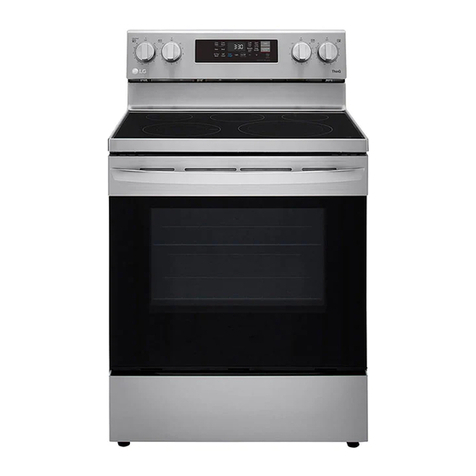
LG
LG LREL6323S/00 User manual
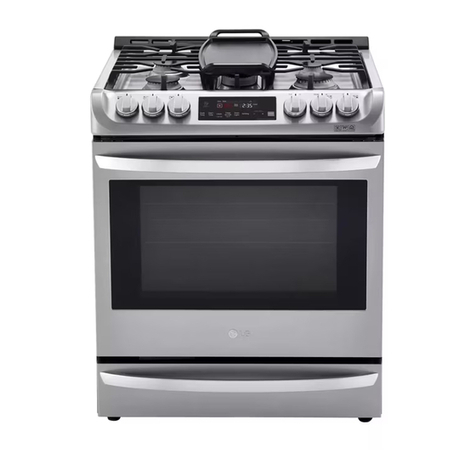
LG
LG LSD4913ST User manual
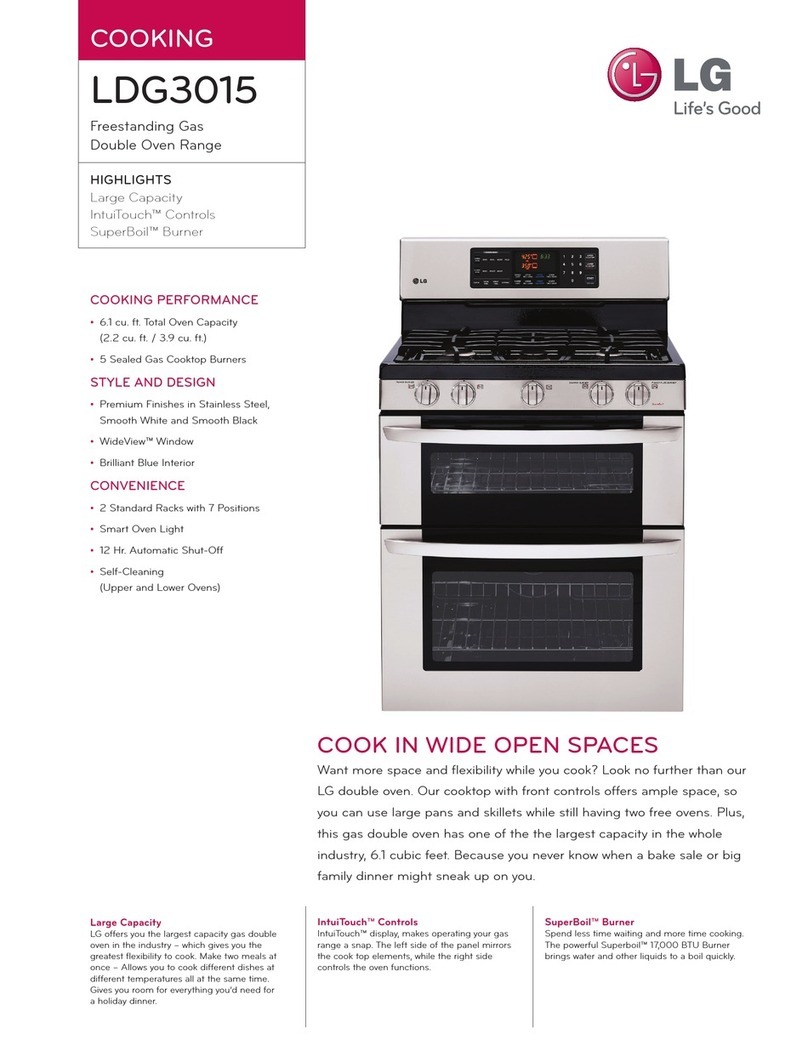
LG
LG LDG3015S User manual
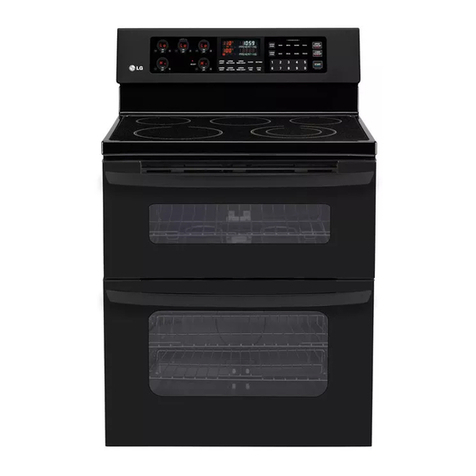
LG
LG LDE3015SB Instruction Manual
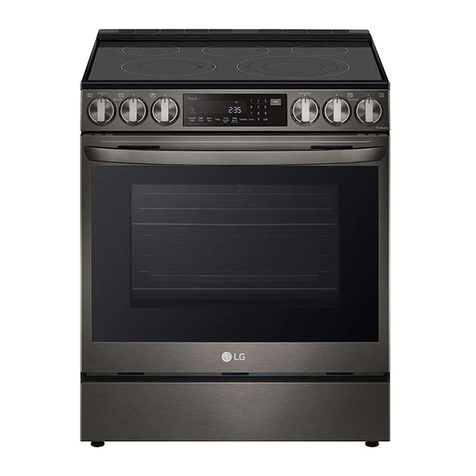
LG
LG LSEL6335F User manual
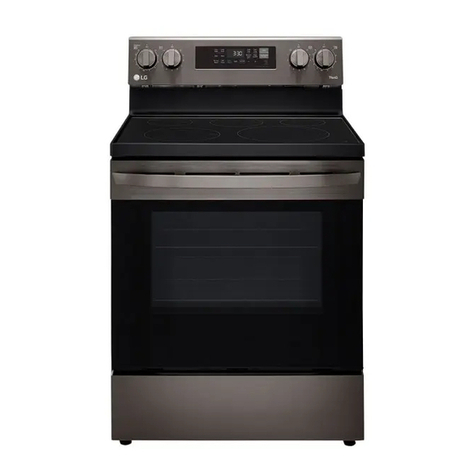
LG
LG LREL6323DLG User manual
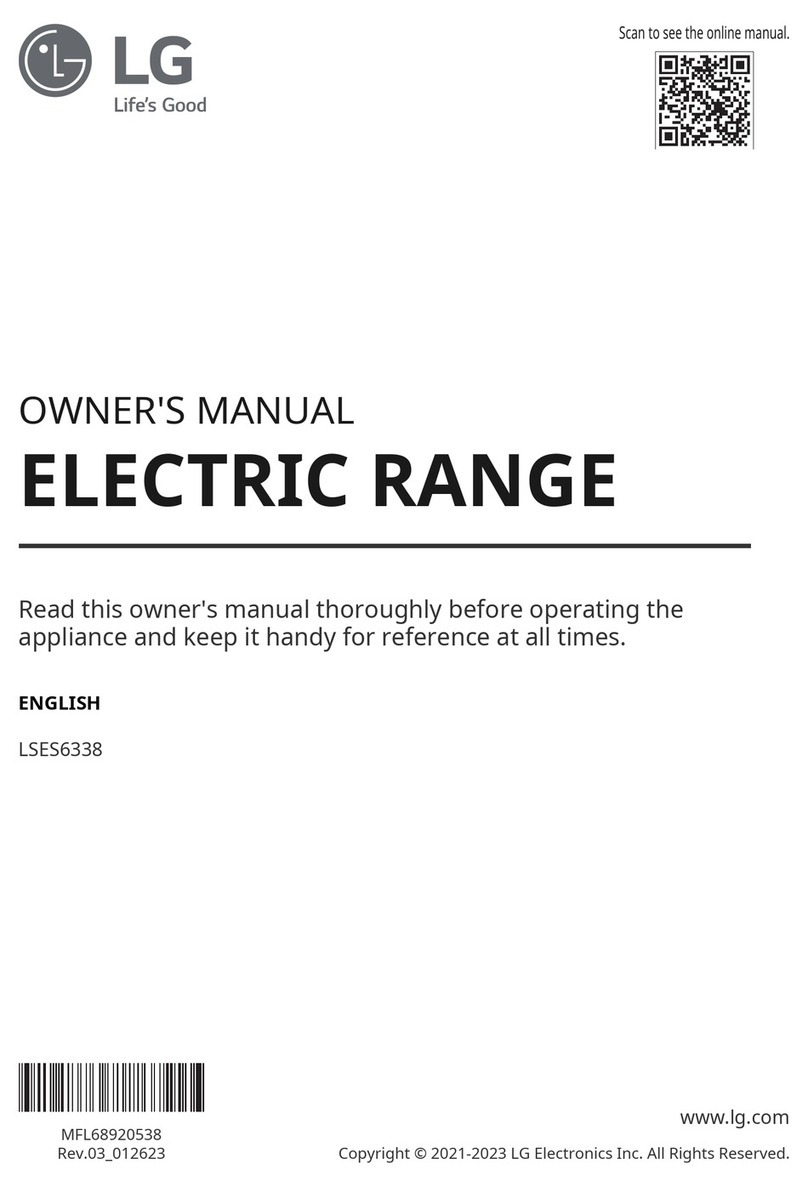
LG
LG LSES6338F.BRSLSTD User manual

LG
LG LSSG3016 Series User manual
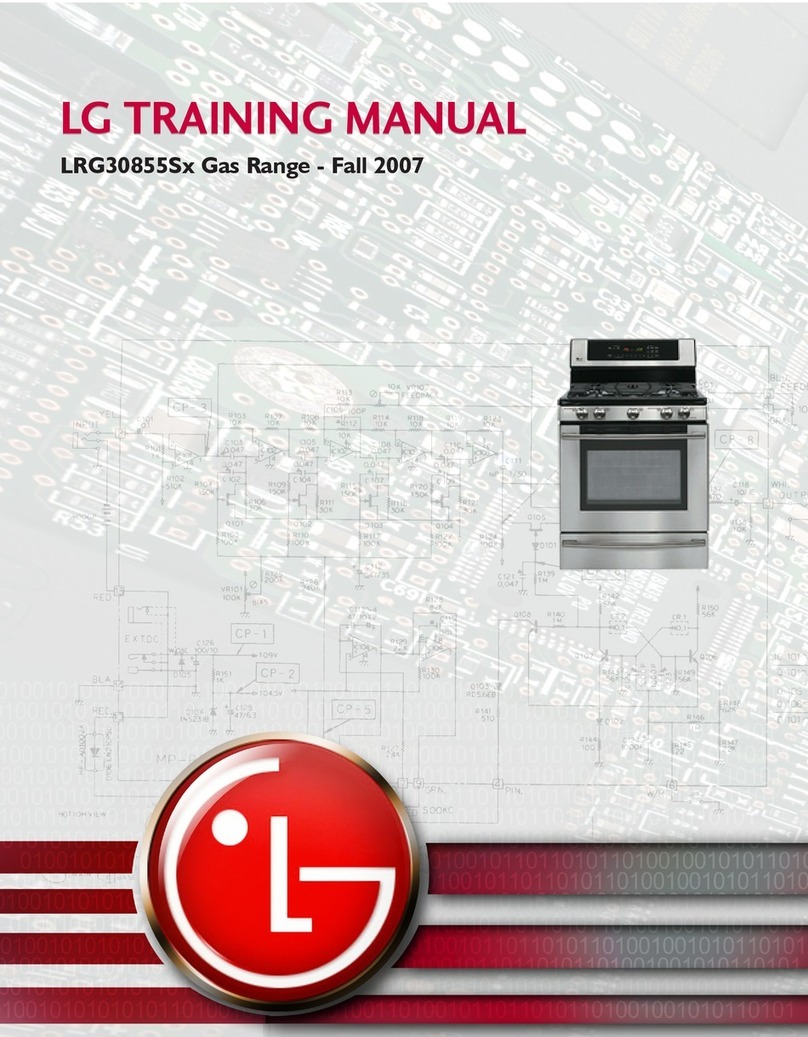
LG
LG LRG30855S Series Installation guide
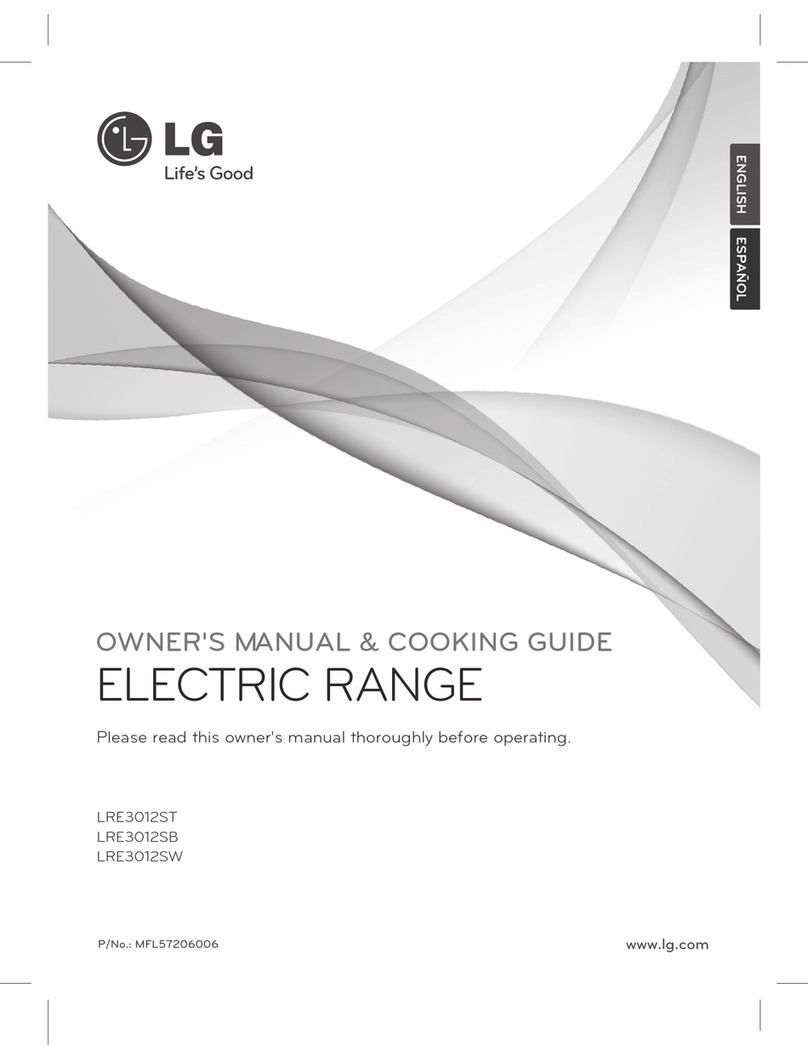
LG
LG LRE3012SB Use and care manual
